Human Resource Management Report: Tarmac vs Titan Cement HRM Analysis
VerifiedAdded on 2023/04/07
|17
|3550
|154
Report
AI Summary
This report provides a detailed analysis of Human Resource Management (HRM) practices, comparing Tarmac UK and Titan Cement UK Ltd. It begins by defining HRM and its importance in organizational success, followed by an examination of HRM planning stages and the reasons behind them within Tarmac. The report then compares the effectiveness of recruitment and selection processes at both companies, highlighting differences in their approaches. Employee motivation is explored through the lens of reward systems at Tarmac, linking them to motivational theories such as Maslow's hierarchy of needs and Herzberg's two-factor theory. Factors determining pay, including job evaluation, are also discussed. Furthermore, the report examines the relevance of reward systems in different contexts within Tarmac and the measures used to monitor staff performance. The report also investigates the reasons for employment secession, employee exit processes, and the influence of legal and regulatory frameworks on employment termination agreements. The report concludes with recommendations based on the HRM analysis conducted.
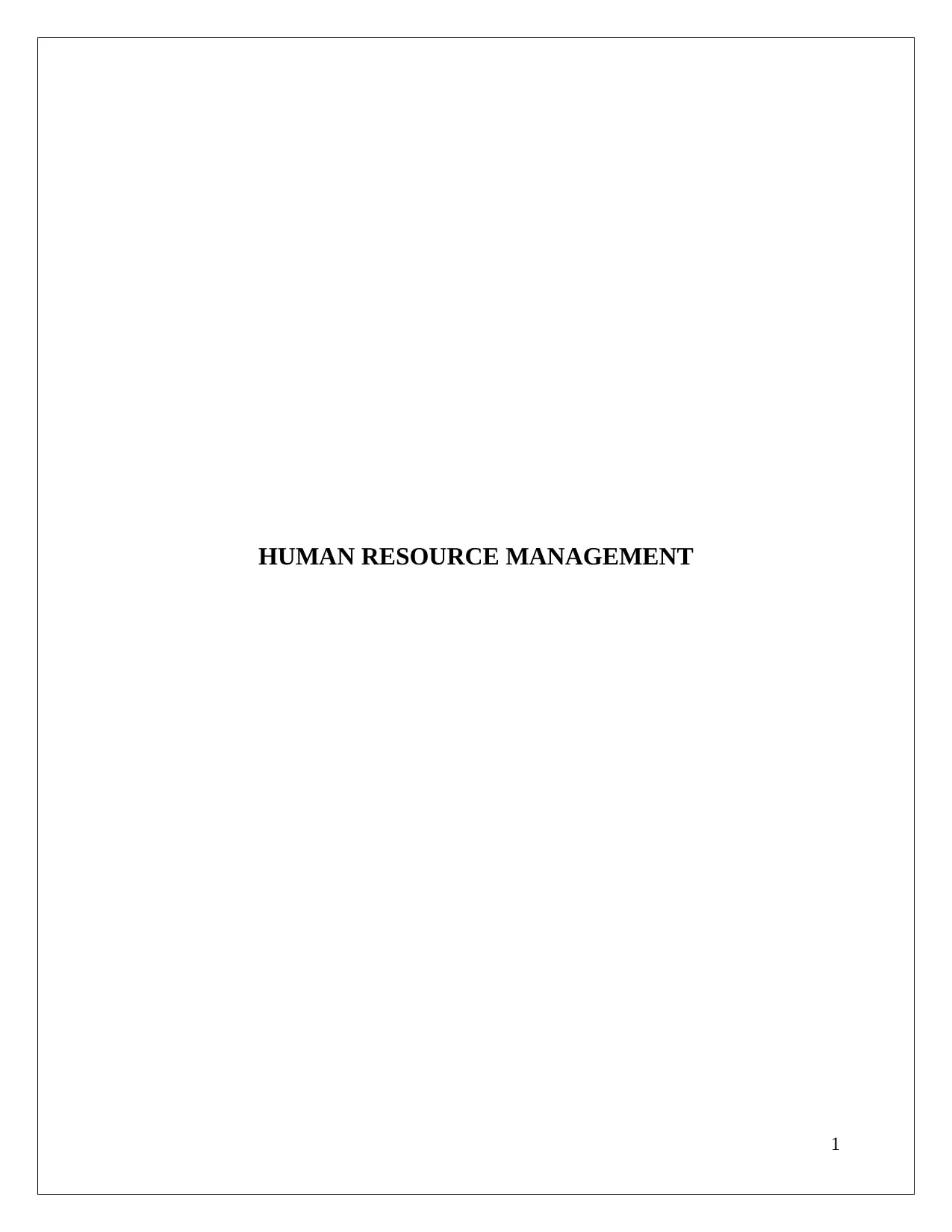
HUMAN RESOURCE MANAGEMENT
1
1
Paraphrase This Document
Need a fresh take? Get an instant paraphrase of this document with our AI Paraphraser
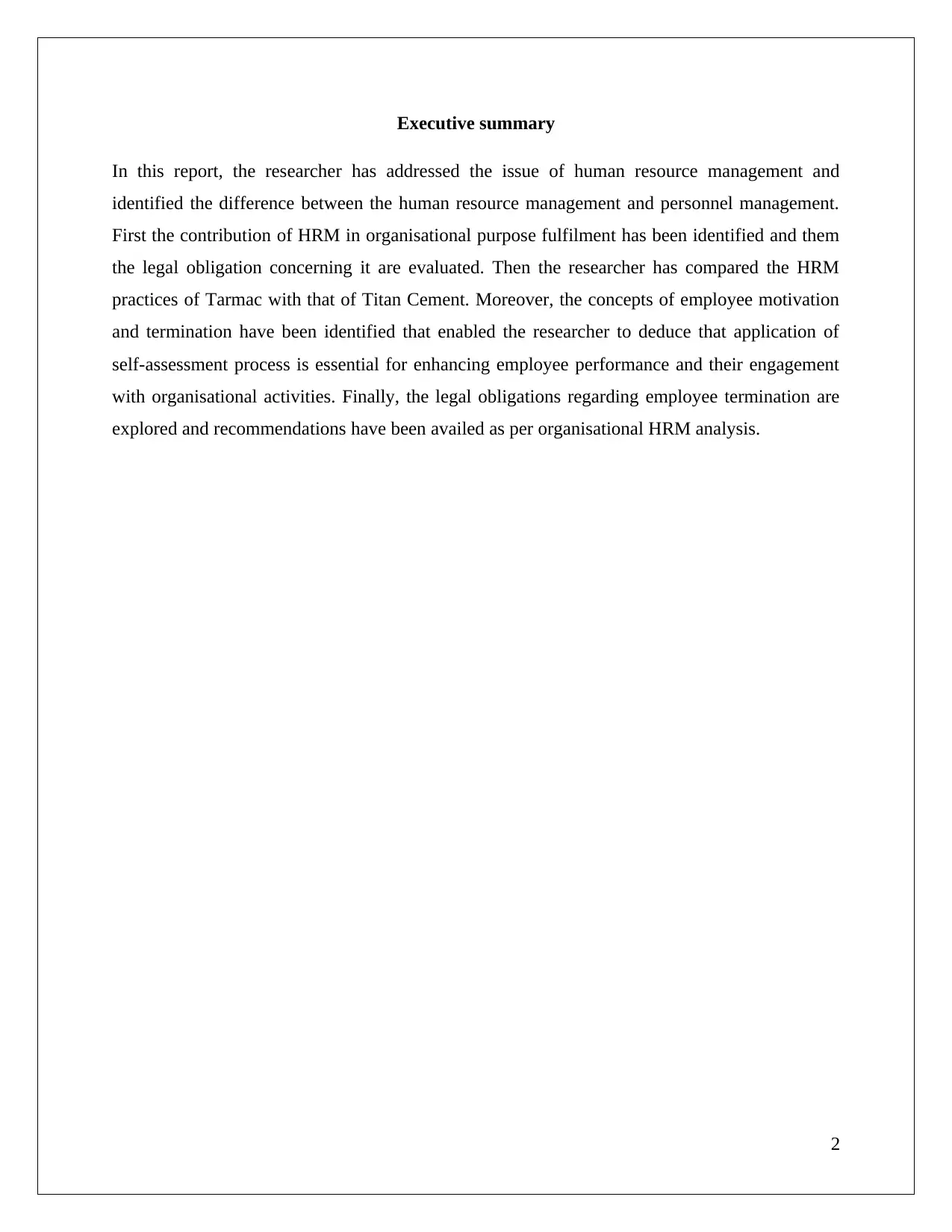
Executive summary
In this report, the researcher has addressed the issue of human resource management and
identified the difference between the human resource management and personnel management.
First the contribution of HRM in organisational purpose fulfilment has been identified and them
the legal obligation concerning it are evaluated. Then the researcher has compared the HRM
practices of Tarmac with that of Titan Cement. Moreover, the concepts of employee motivation
and termination have been identified that enabled the researcher to deduce that application of
self-assessment process is essential for enhancing employee performance and their engagement
with organisational activities. Finally, the legal obligations regarding employee termination are
explored and recommendations have been availed as per organisational HRM analysis.
2
In this report, the researcher has addressed the issue of human resource management and
identified the difference between the human resource management and personnel management.
First the contribution of HRM in organisational purpose fulfilment has been identified and them
the legal obligation concerning it are evaluated. Then the researcher has compared the HRM
practices of Tarmac with that of Titan Cement. Moreover, the concepts of employee motivation
and termination have been identified that enabled the researcher to deduce that application of
self-assessment process is essential for enhancing employee performance and their engagement
with organisational activities. Finally, the legal obligations regarding employee termination are
explored and recommendations have been availed as per organisational HRM analysis.
2
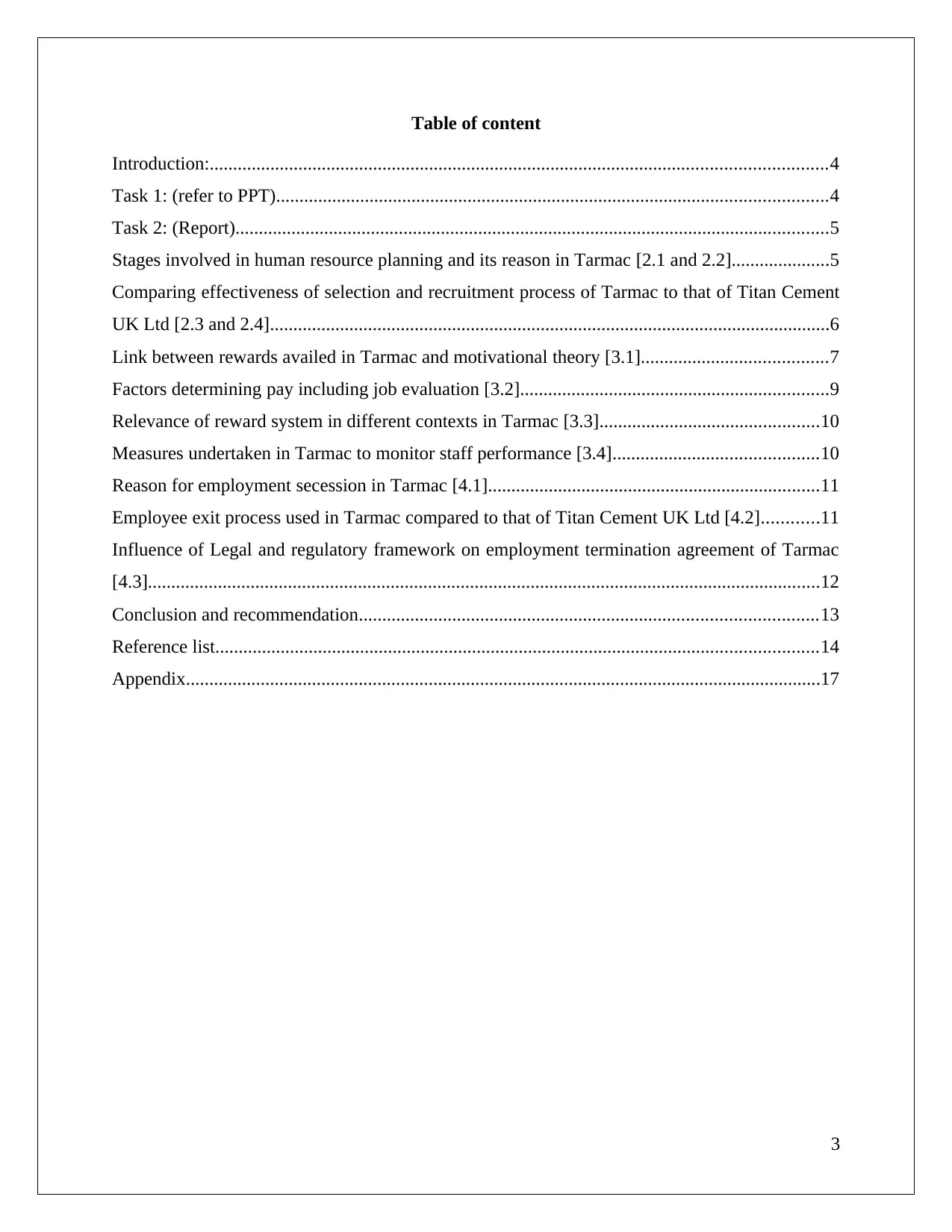
Table of content
Introduction:....................................................................................................................................4
Task 1: (refer to PPT)......................................................................................................................4
Task 2: (Report)...............................................................................................................................5
Stages involved in human resource planning and its reason in Tarmac [2.1 and 2.2].....................5
Comparing effectiveness of selection and recruitment process of Tarmac to that of Titan Cement
UK Ltd [2.3 and 2.4]........................................................................................................................6
Link between rewards availed in Tarmac and motivational theory [3.1]........................................7
Factors determining pay including job evaluation [3.2]..................................................................9
Relevance of reward system in different contexts in Tarmac [3.3]...............................................10
Measures undertaken in Tarmac to monitor staff performance [3.4]............................................10
Reason for employment secession in Tarmac [4.1].......................................................................11
Employee exit process used in Tarmac compared to that of Titan Cement UK Ltd [4.2]............11
Influence of Legal and regulatory framework on employment termination agreement of Tarmac
[4.3]................................................................................................................................................12
Conclusion and recommendation..................................................................................................13
Reference list.................................................................................................................................14
Appendix........................................................................................................................................17
3
Introduction:....................................................................................................................................4
Task 1: (refer to PPT)......................................................................................................................4
Task 2: (Report)...............................................................................................................................5
Stages involved in human resource planning and its reason in Tarmac [2.1 and 2.2].....................5
Comparing effectiveness of selection and recruitment process of Tarmac to that of Titan Cement
UK Ltd [2.3 and 2.4]........................................................................................................................6
Link between rewards availed in Tarmac and motivational theory [3.1]........................................7
Factors determining pay including job evaluation [3.2]..................................................................9
Relevance of reward system in different contexts in Tarmac [3.3]...............................................10
Measures undertaken in Tarmac to monitor staff performance [3.4]............................................10
Reason for employment secession in Tarmac [4.1].......................................................................11
Employee exit process used in Tarmac compared to that of Titan Cement UK Ltd [4.2]............11
Influence of Legal and regulatory framework on employment termination agreement of Tarmac
[4.3]................................................................................................................................................12
Conclusion and recommendation..................................................................................................13
Reference list.................................................................................................................................14
Appendix........................................................................................................................................17
3
⊘ This is a preview!⊘
Do you want full access?
Subscribe today to unlock all pages.

Trusted by 1+ million students worldwide
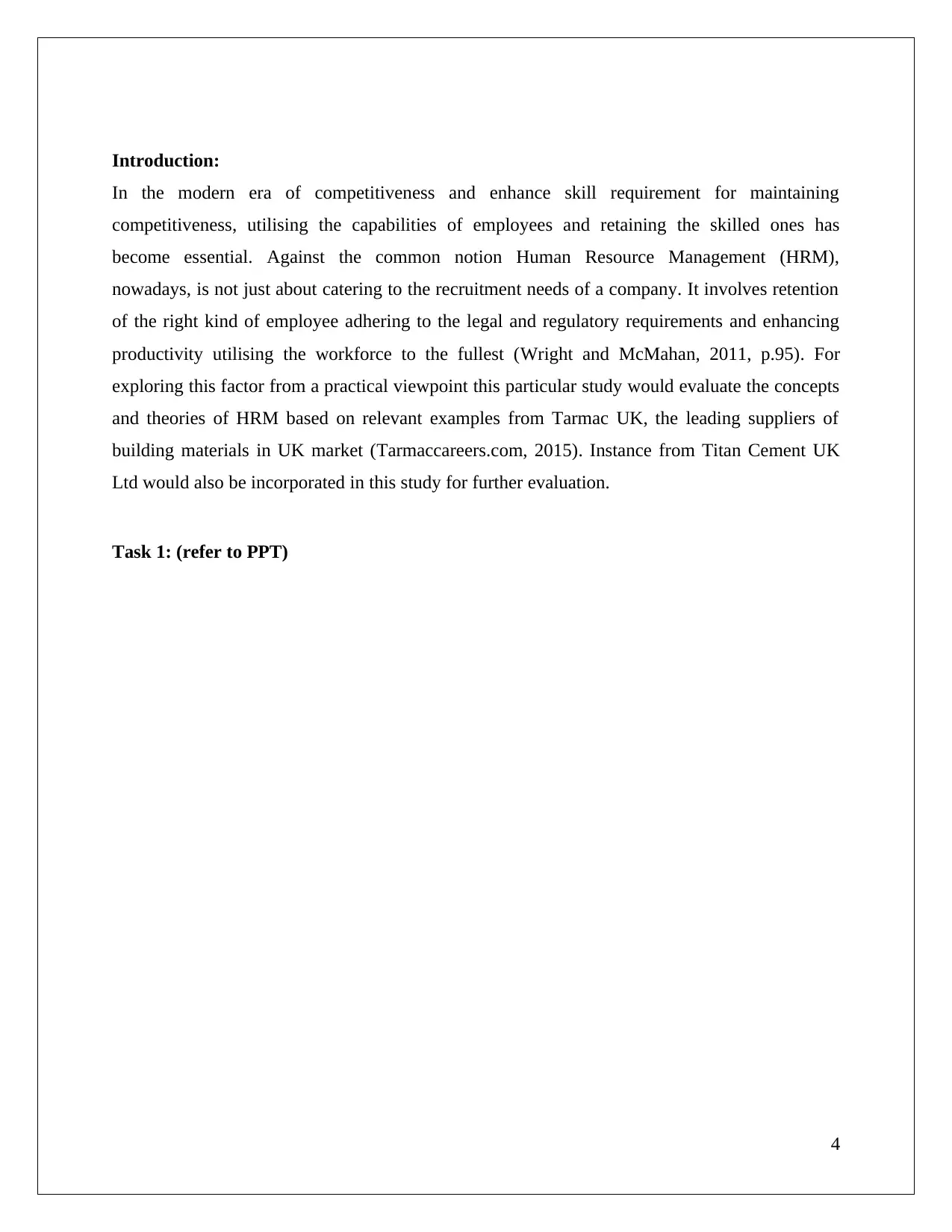
Introduction:
In the modern era of competitiveness and enhance skill requirement for maintaining
competitiveness, utilising the capabilities of employees and retaining the skilled ones has
become essential. Against the common notion Human Resource Management (HRM),
nowadays, is not just about catering to the recruitment needs of a company. It involves retention
of the right kind of employee adhering to the legal and regulatory requirements and enhancing
productivity utilising the workforce to the fullest (Wright and McMahan, 2011, p.95). For
exploring this factor from a practical viewpoint this particular study would evaluate the concepts
and theories of HRM based on relevant examples from Tarmac UK, the leading suppliers of
building materials in UK market (Tarmaccareers.com, 2015). Instance from Titan Cement UK
Ltd would also be incorporated in this study for further evaluation.
Task 1: (refer to PPT)
4
In the modern era of competitiveness and enhance skill requirement for maintaining
competitiveness, utilising the capabilities of employees and retaining the skilled ones has
become essential. Against the common notion Human Resource Management (HRM),
nowadays, is not just about catering to the recruitment needs of a company. It involves retention
of the right kind of employee adhering to the legal and regulatory requirements and enhancing
productivity utilising the workforce to the fullest (Wright and McMahan, 2011, p.95). For
exploring this factor from a practical viewpoint this particular study would evaluate the concepts
and theories of HRM based on relevant examples from Tarmac UK, the leading suppliers of
building materials in UK market (Tarmaccareers.com, 2015). Instance from Titan Cement UK
Ltd would also be incorporated in this study for further evaluation.
Task 1: (refer to PPT)
4
Paraphrase This Document
Need a fresh take? Get an instant paraphrase of this document with our AI Paraphraser
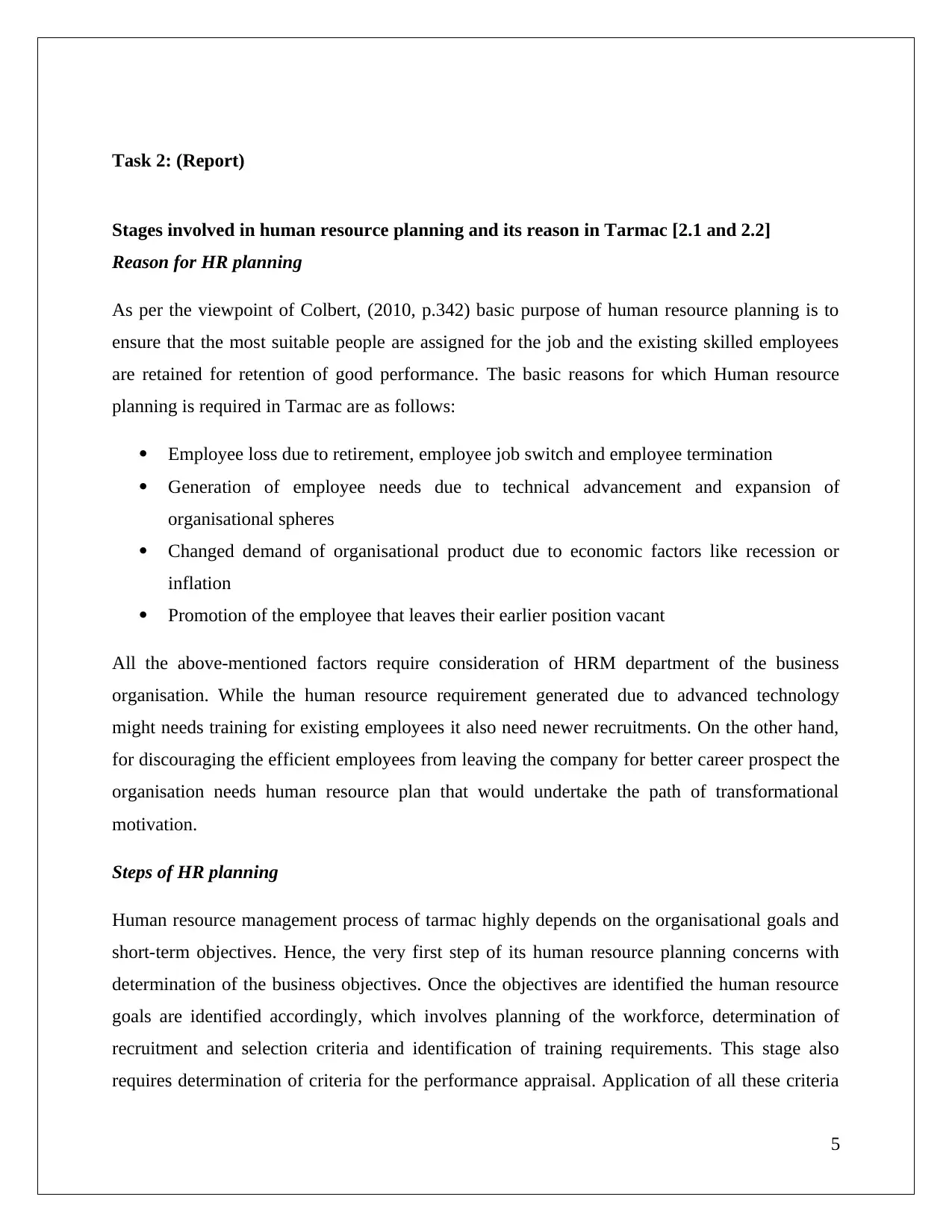
Task 2: (Report)
Stages involved in human resource planning and its reason in Tarmac [2.1 and 2.2]
Reason for HR planning
As per the viewpoint of Colbert, (2010, p.342) basic purpose of human resource planning is to
ensure that the most suitable people are assigned for the job and the existing skilled employees
are retained for retention of good performance. The basic reasons for which Human resource
planning is required in Tarmac are as follows:
Employee loss due to retirement, employee job switch and employee termination
Generation of employee needs due to technical advancement and expansion of
organisational spheres
Changed demand of organisational product due to economic factors like recession or
inflation
Promotion of the employee that leaves their earlier position vacant
All the above-mentioned factors require consideration of HRM department of the business
organisation. While the human resource requirement generated due to advanced technology
might needs training for existing employees it also need newer recruitments. On the other hand,
for discouraging the efficient employees from leaving the company for better career prospect the
organisation needs human resource plan that would undertake the path of transformational
motivation.
Steps of HR planning
Human resource management process of tarmac highly depends on the organisational goals and
short-term objectives. Hence, the very first step of its human resource planning concerns with
determination of the business objectives. Once the objectives are identified the human resource
goals are identified accordingly, which involves planning of the workforce, determination of
recruitment and selection criteria and identification of training requirements. This stage also
requires determination of criteria for the performance appraisal. Application of all these criteria
5
Stages involved in human resource planning and its reason in Tarmac [2.1 and 2.2]
Reason for HR planning
As per the viewpoint of Colbert, (2010, p.342) basic purpose of human resource planning is to
ensure that the most suitable people are assigned for the job and the existing skilled employees
are retained for retention of good performance. The basic reasons for which Human resource
planning is required in Tarmac are as follows:
Employee loss due to retirement, employee job switch and employee termination
Generation of employee needs due to technical advancement and expansion of
organisational spheres
Changed demand of organisational product due to economic factors like recession or
inflation
Promotion of the employee that leaves their earlier position vacant
All the above-mentioned factors require consideration of HRM department of the business
organisation. While the human resource requirement generated due to advanced technology
might needs training for existing employees it also need newer recruitments. On the other hand,
for discouraging the efficient employees from leaving the company for better career prospect the
organisation needs human resource plan that would undertake the path of transformational
motivation.
Steps of HR planning
Human resource management process of tarmac highly depends on the organisational goals and
short-term objectives. Hence, the very first step of its human resource planning concerns with
determination of the business objectives. Once the objectives are identified the human resource
goals are identified accordingly, which involves planning of the workforce, determination of
recruitment and selection criteria and identification of training requirements. This stage also
requires determination of criteria for the performance appraisal. Application of all these criteria
5
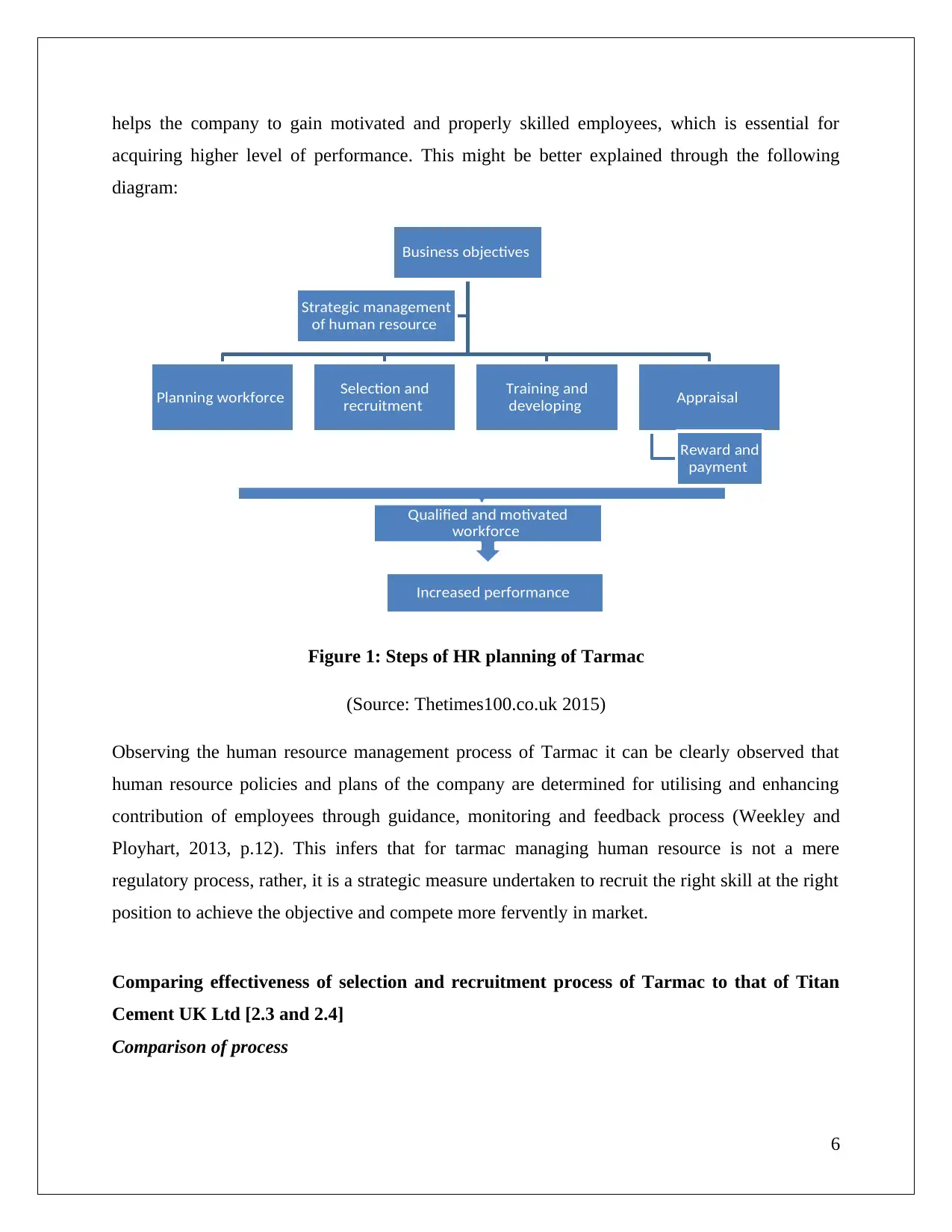
helps the company to gain motivated and properly skilled employees, which is essential for
acquiring higher level of performance. This might be better explained through the following
diagram:
Figure 1: Steps of HR planning of Tarmac
(Source: Thetimes100.co.uk 2015)
Observing the human resource management process of Tarmac it can be clearly observed that
human resource policies and plans of the company are determined for utilising and enhancing
contribution of employees through guidance, monitoring and feedback process (Weekley and
Ployhart, 2013, p.12). This infers that for tarmac managing human resource is not a mere
regulatory process, rather, it is a strategic measure undertaken to recruit the right skill at the right
position to achieve the objective and compete more fervently in market.
Comparing effectiveness of selection and recruitment process of Tarmac to that of Titan
Cement UK Ltd [2.3 and 2.4]
Comparison of process
6
Business objectives
Planning workforce Selection and
recruitment
Qualified and motivated
workforce
Increased performance
Training and
developing Appraisal
Reward and
payment
Strategic management
of human resource
acquiring higher level of performance. This might be better explained through the following
diagram:
Figure 1: Steps of HR planning of Tarmac
(Source: Thetimes100.co.uk 2015)
Observing the human resource management process of Tarmac it can be clearly observed that
human resource policies and plans of the company are determined for utilising and enhancing
contribution of employees through guidance, monitoring and feedback process (Weekley and
Ployhart, 2013, p.12). This infers that for tarmac managing human resource is not a mere
regulatory process, rather, it is a strategic measure undertaken to recruit the right skill at the right
position to achieve the objective and compete more fervently in market.
Comparing effectiveness of selection and recruitment process of Tarmac to that of Titan
Cement UK Ltd [2.3 and 2.4]
Comparison of process
6
Business objectives
Planning workforce Selection and
recruitment
Qualified and motivated
workforce
Increased performance
Training and
developing Appraisal
Reward and
payment
Strategic management
of human resource
⊘ This is a preview!⊘
Do you want full access?
Subscribe today to unlock all pages.

Trusted by 1+ million students worldwide
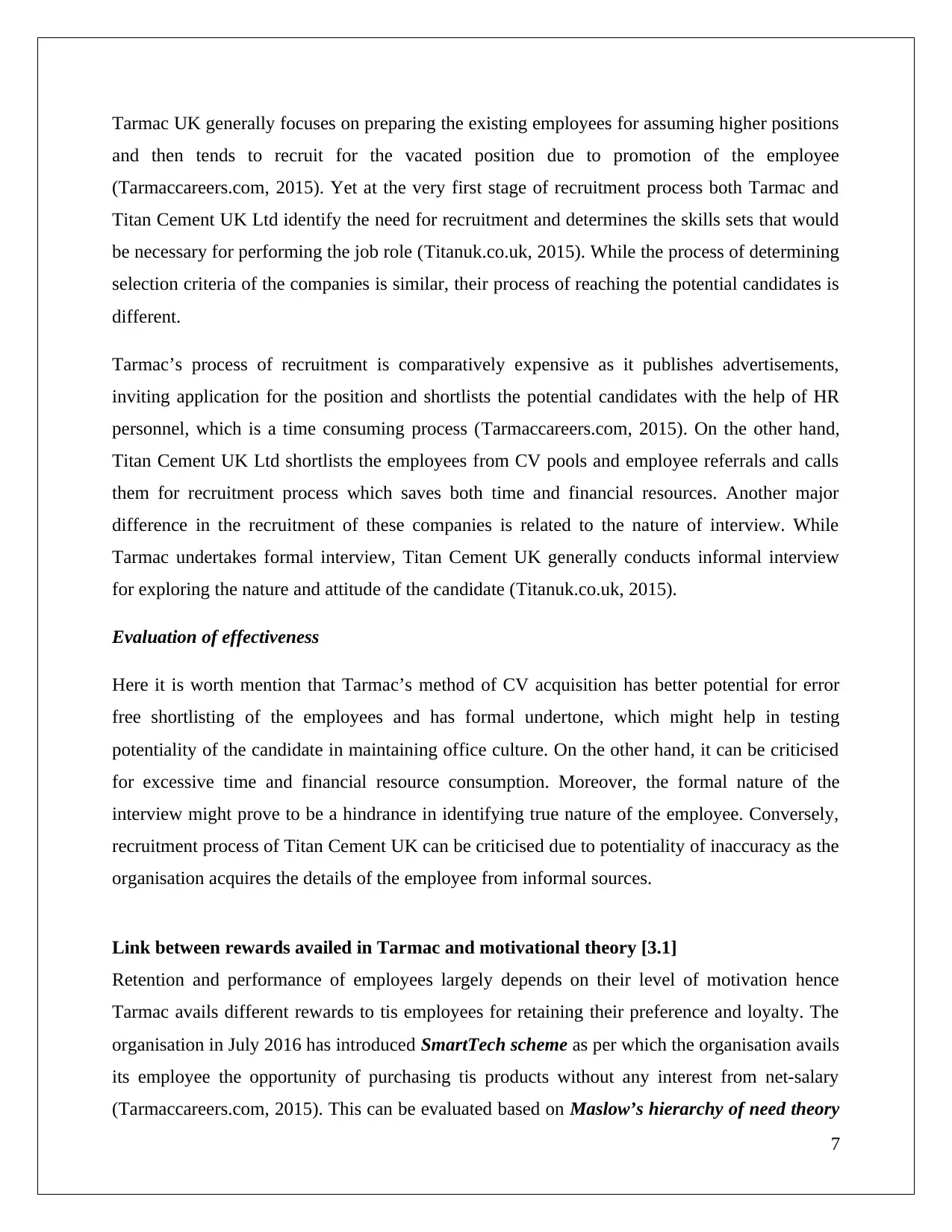
Tarmac UK generally focuses on preparing the existing employees for assuming higher positions
and then tends to recruit for the vacated position due to promotion of the employee
(Tarmaccareers.com, 2015). Yet at the very first stage of recruitment process both Tarmac and
Titan Cement UK Ltd identify the need for recruitment and determines the skills sets that would
be necessary for performing the job role (Titanuk.co.uk, 2015). While the process of determining
selection criteria of the companies is similar, their process of reaching the potential candidates is
different.
Tarmac’s process of recruitment is comparatively expensive as it publishes advertisements,
inviting application for the position and shortlists the potential candidates with the help of HR
personnel, which is a time consuming process (Tarmaccareers.com, 2015). On the other hand,
Titan Cement UK Ltd shortlists the employees from CV pools and employee referrals and calls
them for recruitment process which saves both time and financial resources. Another major
difference in the recruitment of these companies is related to the nature of interview. While
Tarmac undertakes formal interview, Titan Cement UK generally conducts informal interview
for exploring the nature and attitude of the candidate (Titanuk.co.uk, 2015).
Evaluation of effectiveness
Here it is worth mention that Tarmac’s method of CV acquisition has better potential for error
free shortlisting of the employees and has formal undertone, which might help in testing
potentiality of the candidate in maintaining office culture. On the other hand, it can be criticised
for excessive time and financial resource consumption. Moreover, the formal nature of the
interview might prove to be a hindrance in identifying true nature of the employee. Conversely,
recruitment process of Titan Cement UK can be criticised due to potentiality of inaccuracy as the
organisation acquires the details of the employee from informal sources.
Link between rewards availed in Tarmac and motivational theory [3.1]
Retention and performance of employees largely depends on their level of motivation hence
Tarmac avails different rewards to tis employees for retaining their preference and loyalty. The
organisation in July 2016 has introduced SmartTech scheme as per which the organisation avails
its employee the opportunity of purchasing tis products without any interest from net-salary
(Tarmaccareers.com, 2015). This can be evaluated based on Maslow’s hierarchy of need theory
7
and then tends to recruit for the vacated position due to promotion of the employee
(Tarmaccareers.com, 2015). Yet at the very first stage of recruitment process both Tarmac and
Titan Cement UK Ltd identify the need for recruitment and determines the skills sets that would
be necessary for performing the job role (Titanuk.co.uk, 2015). While the process of determining
selection criteria of the companies is similar, their process of reaching the potential candidates is
different.
Tarmac’s process of recruitment is comparatively expensive as it publishes advertisements,
inviting application for the position and shortlists the potential candidates with the help of HR
personnel, which is a time consuming process (Tarmaccareers.com, 2015). On the other hand,
Titan Cement UK Ltd shortlists the employees from CV pools and employee referrals and calls
them for recruitment process which saves both time and financial resources. Another major
difference in the recruitment of these companies is related to the nature of interview. While
Tarmac undertakes formal interview, Titan Cement UK generally conducts informal interview
for exploring the nature and attitude of the candidate (Titanuk.co.uk, 2015).
Evaluation of effectiveness
Here it is worth mention that Tarmac’s method of CV acquisition has better potential for error
free shortlisting of the employees and has formal undertone, which might help in testing
potentiality of the candidate in maintaining office culture. On the other hand, it can be criticised
for excessive time and financial resource consumption. Moreover, the formal nature of the
interview might prove to be a hindrance in identifying true nature of the employee. Conversely,
recruitment process of Titan Cement UK can be criticised due to potentiality of inaccuracy as the
organisation acquires the details of the employee from informal sources.
Link between rewards availed in Tarmac and motivational theory [3.1]
Retention and performance of employees largely depends on their level of motivation hence
Tarmac avails different rewards to tis employees for retaining their preference and loyalty. The
organisation in July 2016 has introduced SmartTech scheme as per which the organisation avails
its employee the opportunity of purchasing tis products without any interest from net-salary
(Tarmaccareers.com, 2015). This can be evaluated based on Maslow’s hierarchy of need theory
7
Paraphrase This Document
Need a fresh take? Get an instant paraphrase of this document with our AI Paraphraser
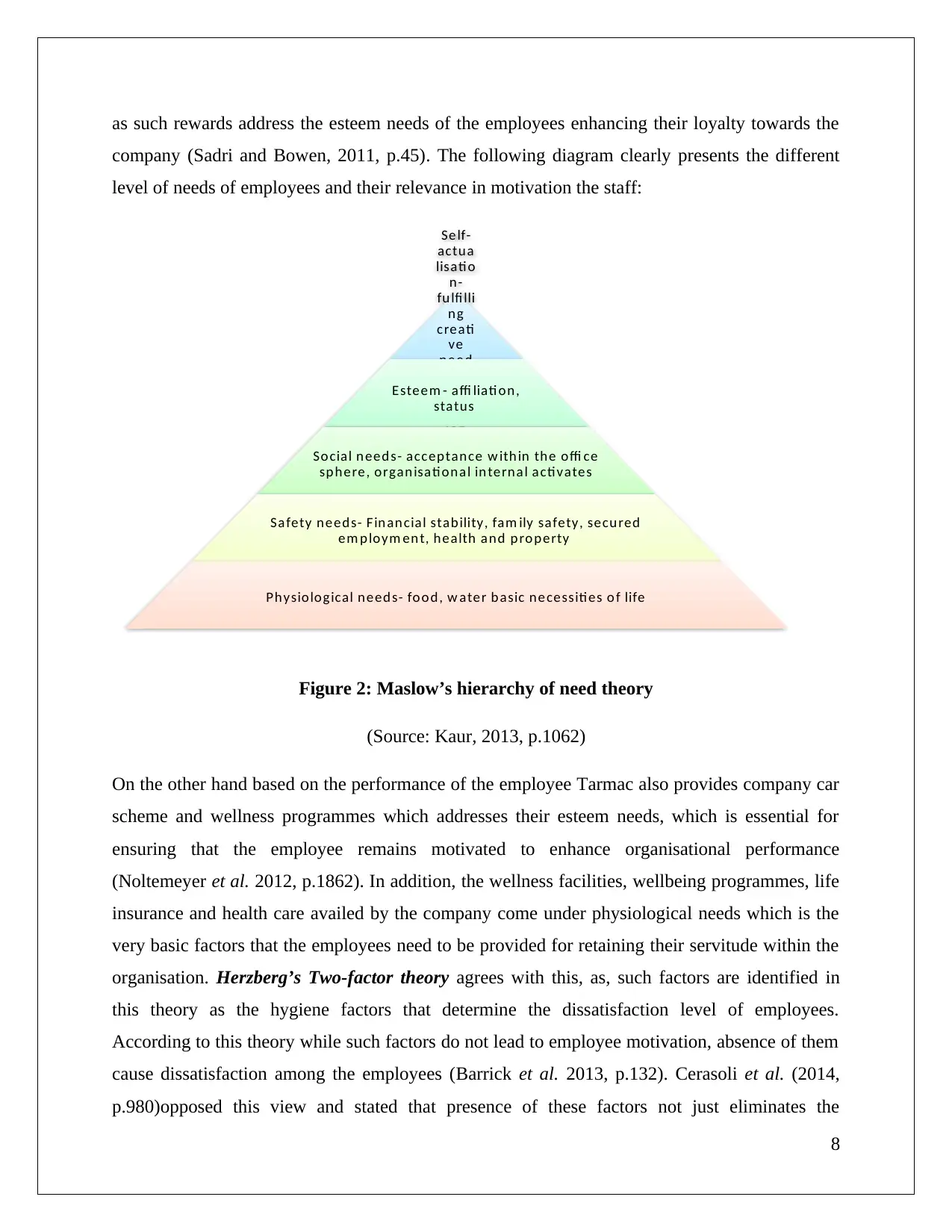
as such rewards address the esteem needs of the employees enhancing their loyalty towards the
company (Sadri and Bowen, 2011, p.45). The following diagram clearly presents the different
level of needs of employees and their relevance in motivation the staff:
Figure 2: Maslow’s hierarchy of need theory
(Source: Kaur, 2013, p.1062)
On the other hand based on the performance of the employee Tarmac also provides company car
scheme and wellness programmes which addresses their esteem needs, which is essential for
ensuring that the employee remains motivated to enhance organisational performance
(Noltemeyer et al. 2012, p.1862). In addition, the wellness facilities, wellbeing programmes, life
insurance and health care availed by the company come under physiological needs which is the
very basic factors that the employees need to be provided for retaining their servitude within the
organisation. Herzberg’s Two-factor theory agrees with this, as, such factors are identified in
this theory as the hygiene factors that determine the dissatisfaction level of employees.
According to this theory while such factors do not lead to employee motivation, absence of them
cause dissatisfaction among the employees (Barrick et al. 2013, p.132). Cerasoli et al. (2014,
p.980)opposed this view and stated that presence of these factors not just eliminates the
8
Se lf-
actua
lisatio
n-
fulfi lli
ng
creati
ve
need
s,
challe
nging
job
role
Esteem - affi liati on,
status
So cial n eeds- acceptance w ithin the offi ce
sphere, organisational internal a ctivates
Sa fety needs- Fin ancial stability, fam ily safety, secured
em ploym en t, health and property
Physiological need s- fo od, w ater basic ne cessities o f life
company (Sadri and Bowen, 2011, p.45). The following diagram clearly presents the different
level of needs of employees and their relevance in motivation the staff:
Figure 2: Maslow’s hierarchy of need theory
(Source: Kaur, 2013, p.1062)
On the other hand based on the performance of the employee Tarmac also provides company car
scheme and wellness programmes which addresses their esteem needs, which is essential for
ensuring that the employee remains motivated to enhance organisational performance
(Noltemeyer et al. 2012, p.1862). In addition, the wellness facilities, wellbeing programmes, life
insurance and health care availed by the company come under physiological needs which is the
very basic factors that the employees need to be provided for retaining their servitude within the
organisation. Herzberg’s Two-factor theory agrees with this, as, such factors are identified in
this theory as the hygiene factors that determine the dissatisfaction level of employees.
According to this theory while such factors do not lead to employee motivation, absence of them
cause dissatisfaction among the employees (Barrick et al. 2013, p.132). Cerasoli et al. (2014,
p.980)opposed this view and stated that presence of these factors not just eliminates the
8
Se lf-
actua
lisatio
n-
fulfi lli
ng
creati
ve
need
s,
challe
nging
job
role
Esteem - affi liati on,
status
So cial n eeds- acceptance w ithin the offi ce
sphere, organisational internal a ctivates
Sa fety needs- Fin ancial stability, fam ily safety, secured
em ploym en t, health and property
Physiological need s- fo od, w ater basic ne cessities o f life
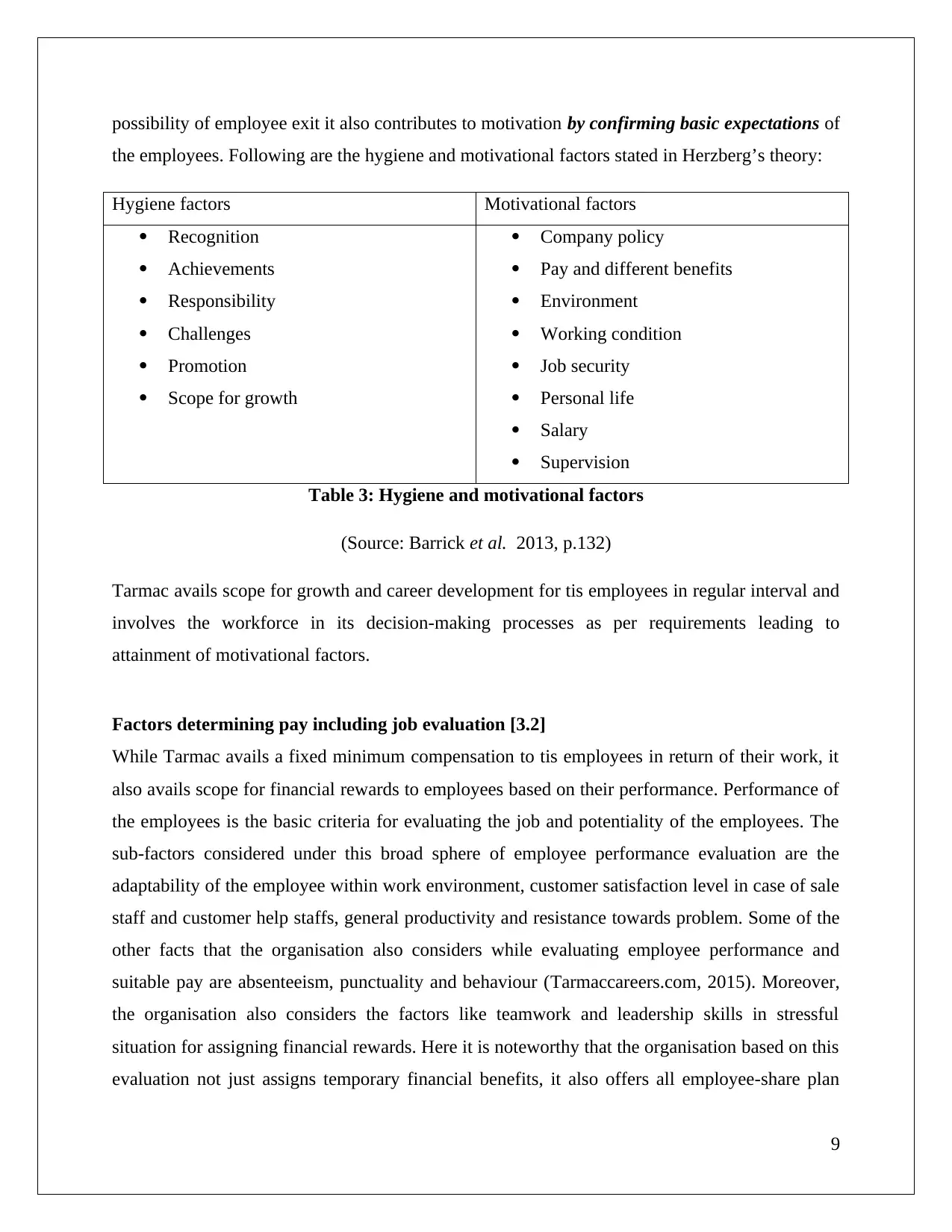
possibility of employee exit it also contributes to motivation by confirming basic expectations of
the employees. Following are the hygiene and motivational factors stated in Herzberg’s theory:
Hygiene factors Motivational factors
Recognition
Achievements
Responsibility
Challenges
Promotion
Scope for growth
Company policy
Pay and different benefits
Environment
Working condition
Job security
Personal life
Salary
Supervision
Table 3: Hygiene and motivational factors
(Source: Barrick et al. 2013, p.132)
Tarmac avails scope for growth and career development for tis employees in regular interval and
involves the workforce in its decision-making processes as per requirements leading to
attainment of motivational factors.
Factors determining pay including job evaluation [3.2]
While Tarmac avails a fixed minimum compensation to tis employees in return of their work, it
also avails scope for financial rewards to employees based on their performance. Performance of
the employees is the basic criteria for evaluating the job and potentiality of the employees. The
sub-factors considered under this broad sphere of employee performance evaluation are the
adaptability of the employee within work environment, customer satisfaction level in case of sale
staff and customer help staffs, general productivity and resistance towards problem. Some of the
other facts that the organisation also considers while evaluating employee performance and
suitable pay are absenteeism, punctuality and behaviour (Tarmaccareers.com, 2015). Moreover,
the organisation also considers the factors like teamwork and leadership skills in stressful
situation for assigning financial rewards. Here it is noteworthy that the organisation based on this
evaluation not just assigns temporary financial benefits, it also offers all employee-share plan
9
the employees. Following are the hygiene and motivational factors stated in Herzberg’s theory:
Hygiene factors Motivational factors
Recognition
Achievements
Responsibility
Challenges
Promotion
Scope for growth
Company policy
Pay and different benefits
Environment
Working condition
Job security
Personal life
Salary
Supervision
Table 3: Hygiene and motivational factors
(Source: Barrick et al. 2013, p.132)
Tarmac avails scope for growth and career development for tis employees in regular interval and
involves the workforce in its decision-making processes as per requirements leading to
attainment of motivational factors.
Factors determining pay including job evaluation [3.2]
While Tarmac avails a fixed minimum compensation to tis employees in return of their work, it
also avails scope for financial rewards to employees based on their performance. Performance of
the employees is the basic criteria for evaluating the job and potentiality of the employees. The
sub-factors considered under this broad sphere of employee performance evaluation are the
adaptability of the employee within work environment, customer satisfaction level in case of sale
staff and customer help staffs, general productivity and resistance towards problem. Some of the
other facts that the organisation also considers while evaluating employee performance and
suitable pay are absenteeism, punctuality and behaviour (Tarmaccareers.com, 2015). Moreover,
the organisation also considers the factors like teamwork and leadership skills in stressful
situation for assigning financial rewards. Here it is noteworthy that the organisation based on this
evaluation not just assigns temporary financial benefits, it also offers all employee-share plan
9
⊘ This is a preview!⊘
Do you want full access?
Subscribe today to unlock all pages.

Trusted by 1+ million students worldwide
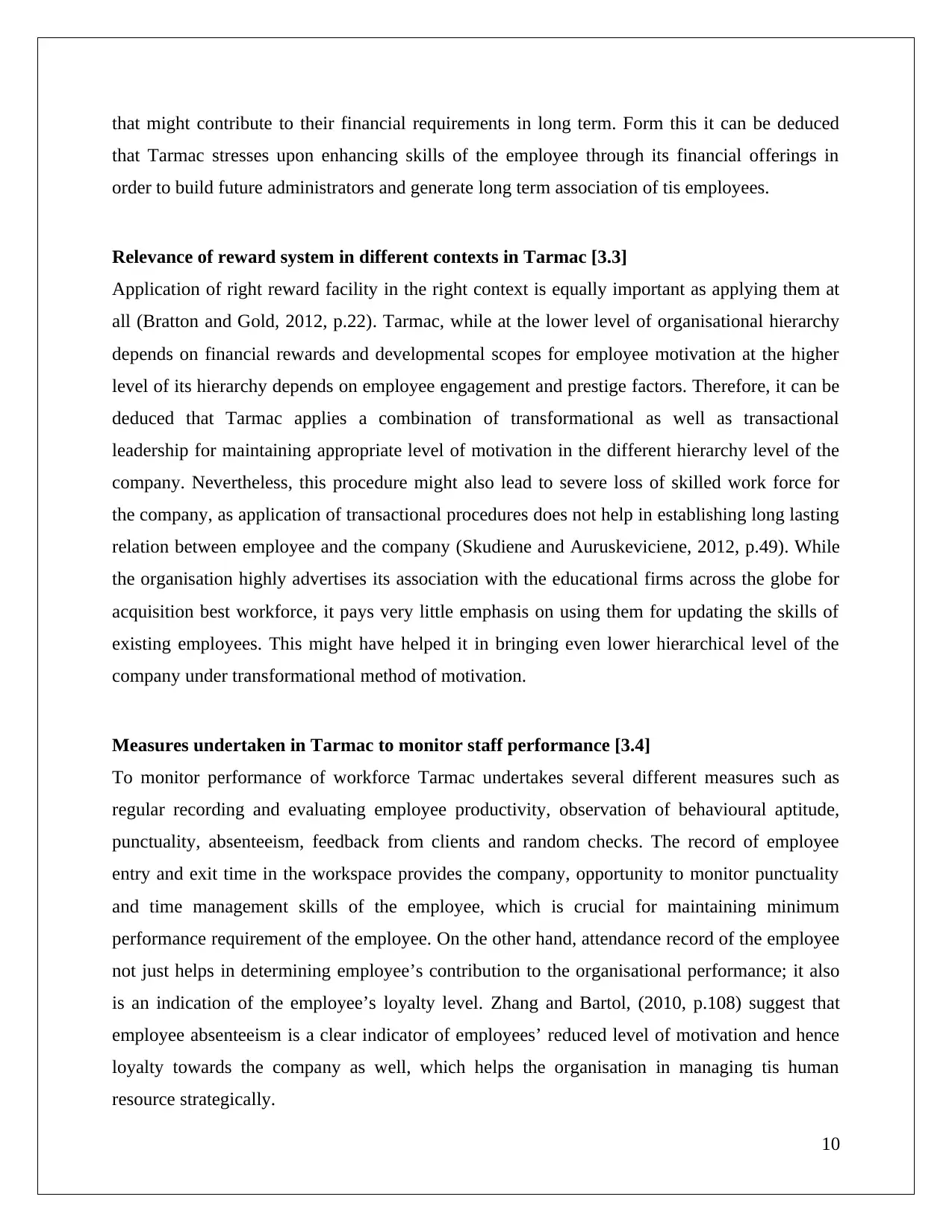
that might contribute to their financial requirements in long term. Form this it can be deduced
that Tarmac stresses upon enhancing skills of the employee through its financial offerings in
order to build future administrators and generate long term association of tis employees.
Relevance of reward system in different contexts in Tarmac [3.3]
Application of right reward facility in the right context is equally important as applying them at
all (Bratton and Gold, 2012, p.22). Tarmac, while at the lower level of organisational hierarchy
depends on financial rewards and developmental scopes for employee motivation at the higher
level of its hierarchy depends on employee engagement and prestige factors. Therefore, it can be
deduced that Tarmac applies a combination of transformational as well as transactional
leadership for maintaining appropriate level of motivation in the different hierarchy level of the
company. Nevertheless, this procedure might also lead to severe loss of skilled work force for
the company, as application of transactional procedures does not help in establishing long lasting
relation between employee and the company (Skudiene and Auruskeviciene, 2012, p.49). While
the organisation highly advertises its association with the educational firms across the globe for
acquisition best workforce, it pays very little emphasis on using them for updating the skills of
existing employees. This might have helped it in bringing even lower hierarchical level of the
company under transformational method of motivation.
Measures undertaken in Tarmac to monitor staff performance [3.4]
To monitor performance of workforce Tarmac undertakes several different measures such as
regular recording and evaluating employee productivity, observation of behavioural aptitude,
punctuality, absenteeism, feedback from clients and random checks. The record of employee
entry and exit time in the workspace provides the company, opportunity to monitor punctuality
and time management skills of the employee, which is crucial for maintaining minimum
performance requirement of the employee. On the other hand, attendance record of the employee
not just helps in determining employee’s contribution to the organisational performance; it also
is an indication of the employee’s loyalty level. Zhang and Bartol, (2010, p.108) suggest that
employee absenteeism is a clear indicator of employees’ reduced level of motivation and hence
loyalty towards the company as well, which helps the organisation in managing tis human
resource strategically.
10
that Tarmac stresses upon enhancing skills of the employee through its financial offerings in
order to build future administrators and generate long term association of tis employees.
Relevance of reward system in different contexts in Tarmac [3.3]
Application of right reward facility in the right context is equally important as applying them at
all (Bratton and Gold, 2012, p.22). Tarmac, while at the lower level of organisational hierarchy
depends on financial rewards and developmental scopes for employee motivation at the higher
level of its hierarchy depends on employee engagement and prestige factors. Therefore, it can be
deduced that Tarmac applies a combination of transformational as well as transactional
leadership for maintaining appropriate level of motivation in the different hierarchy level of the
company. Nevertheless, this procedure might also lead to severe loss of skilled work force for
the company, as application of transactional procedures does not help in establishing long lasting
relation between employee and the company (Skudiene and Auruskeviciene, 2012, p.49). While
the organisation highly advertises its association with the educational firms across the globe for
acquisition best workforce, it pays very little emphasis on using them for updating the skills of
existing employees. This might have helped it in bringing even lower hierarchical level of the
company under transformational method of motivation.
Measures undertaken in Tarmac to monitor staff performance [3.4]
To monitor performance of workforce Tarmac undertakes several different measures such as
regular recording and evaluating employee productivity, observation of behavioural aptitude,
punctuality, absenteeism, feedback from clients and random checks. The record of employee
entry and exit time in the workspace provides the company, opportunity to monitor punctuality
and time management skills of the employee, which is crucial for maintaining minimum
performance requirement of the employee. On the other hand, attendance record of the employee
not just helps in determining employee’s contribution to the organisational performance; it also
is an indication of the employee’s loyalty level. Zhang and Bartol, (2010, p.108) suggest that
employee absenteeism is a clear indicator of employees’ reduced level of motivation and hence
loyalty towards the company as well, which helps the organisation in managing tis human
resource strategically.
10
Paraphrase This Document
Need a fresh take? Get an instant paraphrase of this document with our AI Paraphraser
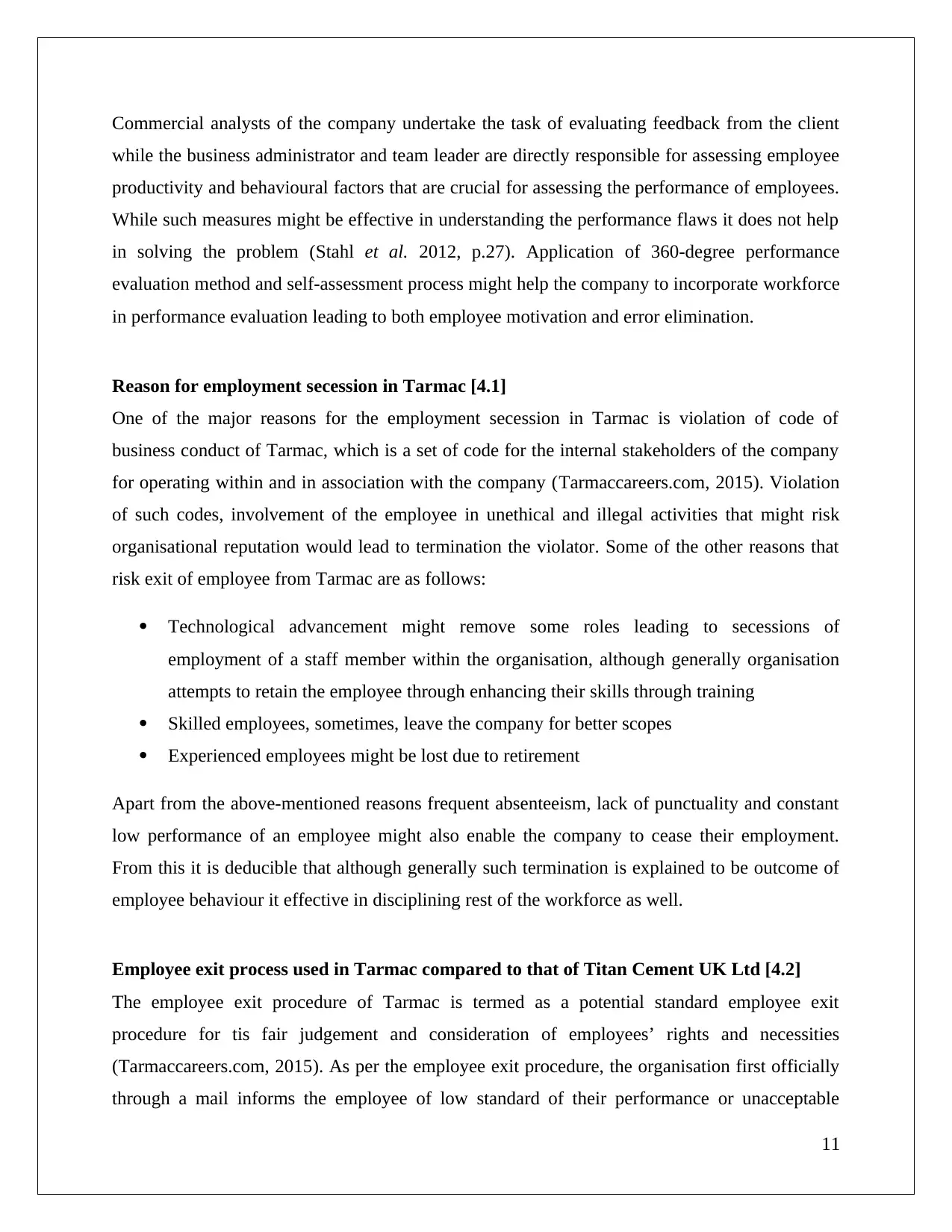
Commercial analysts of the company undertake the task of evaluating feedback from the client
while the business administrator and team leader are directly responsible for assessing employee
productivity and behavioural factors that are crucial for assessing the performance of employees.
While such measures might be effective in understanding the performance flaws it does not help
in solving the problem (Stahl et al. 2012, p.27). Application of 360-degree performance
evaluation method and self-assessment process might help the company to incorporate workforce
in performance evaluation leading to both employee motivation and error elimination.
Reason for employment secession in Tarmac [4.1]
One of the major reasons for the employment secession in Tarmac is violation of code of
business conduct of Tarmac, which is a set of code for the internal stakeholders of the company
for operating within and in association with the company (Tarmaccareers.com, 2015). Violation
of such codes, involvement of the employee in unethical and illegal activities that might risk
organisational reputation would lead to termination the violator. Some of the other reasons that
risk exit of employee from Tarmac are as follows:
Technological advancement might remove some roles leading to secessions of
employment of a staff member within the organisation, although generally organisation
attempts to retain the employee through enhancing their skills through training
Skilled employees, sometimes, leave the company for better scopes
Experienced employees might be lost due to retirement
Apart from the above-mentioned reasons frequent absenteeism, lack of punctuality and constant
low performance of an employee might also enable the company to cease their employment.
From this it is deducible that although generally such termination is explained to be outcome of
employee behaviour it effective in disciplining rest of the workforce as well.
Employee exit process used in Tarmac compared to that of Titan Cement UK Ltd [4.2]
The employee exit procedure of Tarmac is termed as a potential standard employee exit
procedure for tis fair judgement and consideration of employees’ rights and necessities
(Tarmaccareers.com, 2015). As per the employee exit procedure, the organisation first officially
through a mail informs the employee of low standard of their performance or unacceptable
11
while the business administrator and team leader are directly responsible for assessing employee
productivity and behavioural factors that are crucial for assessing the performance of employees.
While such measures might be effective in understanding the performance flaws it does not help
in solving the problem (Stahl et al. 2012, p.27). Application of 360-degree performance
evaluation method and self-assessment process might help the company to incorporate workforce
in performance evaluation leading to both employee motivation and error elimination.
Reason for employment secession in Tarmac [4.1]
One of the major reasons for the employment secession in Tarmac is violation of code of
business conduct of Tarmac, which is a set of code for the internal stakeholders of the company
for operating within and in association with the company (Tarmaccareers.com, 2015). Violation
of such codes, involvement of the employee in unethical and illegal activities that might risk
organisational reputation would lead to termination the violator. Some of the other reasons that
risk exit of employee from Tarmac are as follows:
Technological advancement might remove some roles leading to secessions of
employment of a staff member within the organisation, although generally organisation
attempts to retain the employee through enhancing their skills through training
Skilled employees, sometimes, leave the company for better scopes
Experienced employees might be lost due to retirement
Apart from the above-mentioned reasons frequent absenteeism, lack of punctuality and constant
low performance of an employee might also enable the company to cease their employment.
From this it is deducible that although generally such termination is explained to be outcome of
employee behaviour it effective in disciplining rest of the workforce as well.
Employee exit process used in Tarmac compared to that of Titan Cement UK Ltd [4.2]
The employee exit procedure of Tarmac is termed as a potential standard employee exit
procedure for tis fair judgement and consideration of employees’ rights and necessities
(Tarmaccareers.com, 2015). As per the employee exit procedure, the organisation first officially
through a mail informs the employee of low standard of their performance or unacceptable
11
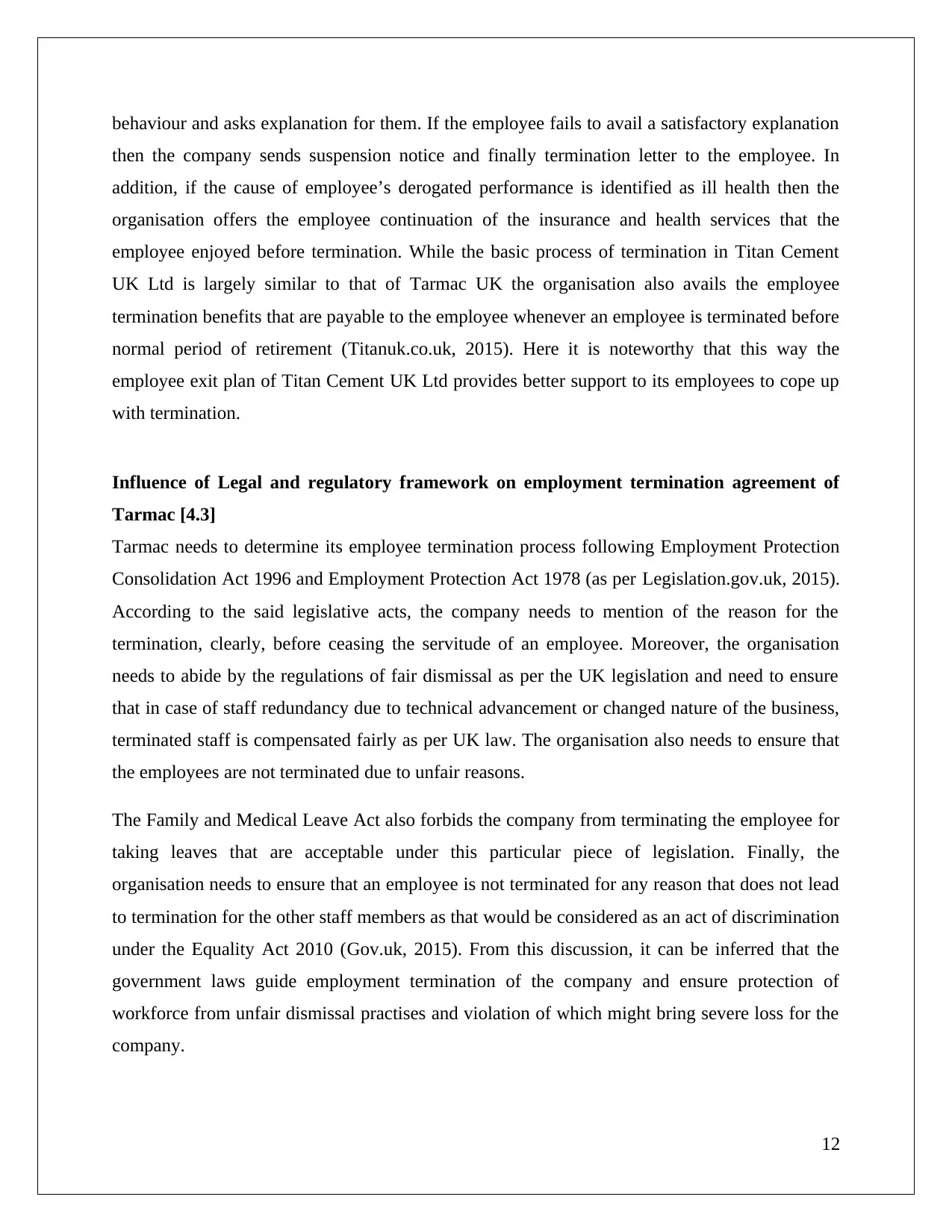
behaviour and asks explanation for them. If the employee fails to avail a satisfactory explanation
then the company sends suspension notice and finally termination letter to the employee. In
addition, if the cause of employee’s derogated performance is identified as ill health then the
organisation offers the employee continuation of the insurance and health services that the
employee enjoyed before termination. While the basic process of termination in Titan Cement
UK Ltd is largely similar to that of Tarmac UK the organisation also avails the employee
termination benefits that are payable to the employee whenever an employee is terminated before
normal period of retirement (Titanuk.co.uk, 2015). Here it is noteworthy that this way the
employee exit plan of Titan Cement UK Ltd provides better support to its employees to cope up
with termination.
Influence of Legal and regulatory framework on employment termination agreement of
Tarmac [4.3]
Tarmac needs to determine its employee termination process following Employment Protection
Consolidation Act 1996 and Employment Protection Act 1978 (as per Legislation.gov.uk, 2015).
According to the said legislative acts, the company needs to mention of the reason for the
termination, clearly, before ceasing the servitude of an employee. Moreover, the organisation
needs to abide by the regulations of fair dismissal as per the UK legislation and need to ensure
that in case of staff redundancy due to technical advancement or changed nature of the business,
terminated staff is compensated fairly as per UK law. The organisation also needs to ensure that
the employees are not terminated due to unfair reasons.
The Family and Medical Leave Act also forbids the company from terminating the employee for
taking leaves that are acceptable under this particular piece of legislation. Finally, the
organisation needs to ensure that an employee is not terminated for any reason that does not lead
to termination for the other staff members as that would be considered as an act of discrimination
under the Equality Act 2010 (Gov.uk, 2015). From this discussion, it can be inferred that the
government laws guide employment termination of the company and ensure protection of
workforce from unfair dismissal practises and violation of which might bring severe loss for the
company.
12
then the company sends suspension notice and finally termination letter to the employee. In
addition, if the cause of employee’s derogated performance is identified as ill health then the
organisation offers the employee continuation of the insurance and health services that the
employee enjoyed before termination. While the basic process of termination in Titan Cement
UK Ltd is largely similar to that of Tarmac UK the organisation also avails the employee
termination benefits that are payable to the employee whenever an employee is terminated before
normal period of retirement (Titanuk.co.uk, 2015). Here it is noteworthy that this way the
employee exit plan of Titan Cement UK Ltd provides better support to its employees to cope up
with termination.
Influence of Legal and regulatory framework on employment termination agreement of
Tarmac [4.3]
Tarmac needs to determine its employee termination process following Employment Protection
Consolidation Act 1996 and Employment Protection Act 1978 (as per Legislation.gov.uk, 2015).
According to the said legislative acts, the company needs to mention of the reason for the
termination, clearly, before ceasing the servitude of an employee. Moreover, the organisation
needs to abide by the regulations of fair dismissal as per the UK legislation and need to ensure
that in case of staff redundancy due to technical advancement or changed nature of the business,
terminated staff is compensated fairly as per UK law. The organisation also needs to ensure that
the employees are not terminated due to unfair reasons.
The Family and Medical Leave Act also forbids the company from terminating the employee for
taking leaves that are acceptable under this particular piece of legislation. Finally, the
organisation needs to ensure that an employee is not terminated for any reason that does not lead
to termination for the other staff members as that would be considered as an act of discrimination
under the Equality Act 2010 (Gov.uk, 2015). From this discussion, it can be inferred that the
government laws guide employment termination of the company and ensure protection of
workforce from unfair dismissal practises and violation of which might bring severe loss for the
company.
12
⊘ This is a preview!⊘
Do you want full access?
Subscribe today to unlock all pages.

Trusted by 1+ million students worldwide
1 out of 17
Related Documents
Your All-in-One AI-Powered Toolkit for Academic Success.
+13062052269
info@desklib.com
Available 24*7 on WhatsApp / Email
![[object Object]](/_next/static/media/star-bottom.7253800d.svg)
Unlock your academic potential
Copyright © 2020–2025 A2Z Services. All Rights Reserved. Developed and managed by ZUCOL.





